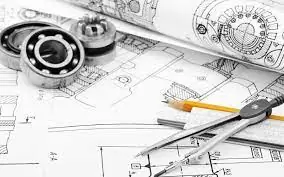If you are conversant with the CNC industry, GD&T is a term that you will have heard at least once. In the simplest way possible, GD&T refers to geometric dimensioning and tolerances, a system or language of symbols used by CNC machinists to communicate how to effectively translate a design into a physical functional part.
GD&T helps engineers and designers communicate just about everything in part design. This language of symbols encompasses shapes, dimensions and tolerance specifications that flows into the quality of the manufacturing. With GD&T, the design intent and functionality is communicated with clarity and brevity among the design, production and quality control teams. It eliminates any ambiguity in part design, and goes a long way in managing the inherent variations that may exist between the original design models and final parts through all the variations that may occur in real-life manufacturing operations.
What is GD&T
Geometric dimensioning and tolerancing is a standard method for communicating engineering dimensions, tolerances and design information. It consists of a number of specifications that define the shape, size, position, form and acceptable variations in every product development process.
GD&T provides answers around the functionality of a product even when they have been manufactured a couple of inches or meters off the CAD model specifications. GD&T also covers part orientation and communicates how a part may relate with other parts that will be assembled or used along with it.

What does GD&T do?
GD&T guides engineers and quality control analysts on the amount of acceptable variations a part can have without losing efficacy in its usability. This is addressed through the following:
i. Clarifies how a part is to be measured and inspected.
ii. Allows the use for pass/fail inspection blocks.
iii. Provides a clear reference coordinate system.
iv. Communicates critical and non-critical features, reducing the time and cost that may be incurred from putting tight tolerances on unimportant parts/features.

How GD&T works
By default, the engineering drawings of any part denotes the dimensions (length, width and depth) of every feature that makes up the part. In the same unit in which these dimensions have been specified, the tolerances (acceptable minimum and maximum deviations) must be specified.
Let us assume a part that can be made to 100mm and 120mm in height. In this case, 20mm is the tolerance. This is the basic plus and minus tolerancing system. Let us now assume that the tolerance for the part allows 100mm height on one side and 120mm on the other. To properly tolerance the part, a symbol may be needed to communicate the design intent of the flat surface. In that case, a flatness tolerance must be must also be included.
Through the use of shapes and symbols, GD&T can communicate much more than length and breadth variations. It can describe the design intent, and hint at the expected geometry and communicates a representation of the actual object rather than the object itself. Within GD&T, the “geometric” arm helps designers and engineers to describe forms like plan, cylinder, square, circular, flat and more.
Why implement GD&T?
The importance of GD&T is already obvious from the article so far. It is however, even more significant for functional assemblies, complex parts and multi-part end-use products. When used accurately, GD&T can allow for statistical process control, aiding the reduction of assembly failures and improving overall quality control.
GD&T also ensured that all relevant fits and feature are accurately denoted in a way that it impacts the manufacturing process to guarantee conformance and functionality. Tightening tolerances can raise part cost up to 2x and higher due to higher tooling costs. GD&T saves cost by preventing unnecessary use of tight tolerances in non-critical features or parts. Here are some other reasons to implement GD&T:
i. Improved communication
GD&T language ensures the much-needed clarity and synergy between engineering, design, production and quality control teams. This can help mitigate costly errors and shorten leadtime as everyone is on the same page on what designs are to be achieved.
ii. Enhanced flexibility
Contrary to what you may think, GD&T actually allows for looser tolerances than tighter ones. It places emphasis on specifying critical features and the amount of deviations acceptable for non-critical features without losing functionality.
Through GD&T, an engineer can read how the position of a feature can vary while still allowing proper assembly, and how the largest tolerance dimensions can be used without worrying about part functionality. All of these flexibilities often translate into a less expensive landing cost.
iii. Higher reliability and quality control
With GD&T, part production becomes more repeatable and consistent. This is because GD&T approaches avoids the misinterpretations that can arise from personal interpretations of drawing notes. There is a clear annotation of the dimensional and functional specifications to be achieved.
FirstPart CNC Machining in China
FirstPart is one of China’s leading manufacturing hub for Additive, CNC and Conventional manufacturing techniques. We boast of excellent in-house capacity, labor force and logistics while delivering exceptional value for money.
Our array of services includes CNC machining, CNC turning, CNC milling, 3D printing, Rapid Tooling, Die casting, Rapid prototyping, Plastic Injection Molding, Urethane Casting, Aluminum Extrusion, Post-machining/Finishing services and much more.
We offer product tooling, mass production, bridge tooling and low-volume prototyping/manufacturing with very flexible minimum order quantities (1 to 100,000). Our services are online, scalable and innovative, with a team of engineers and design experts available to support you through your entire product development cycle.










